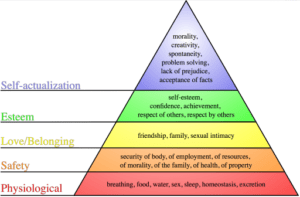Maslow’s Hierarchy of Needs: A Brief Overview

Before delving into the connection between Maslow’s hierarchy and environmental health, let’s briefly review the five tiers of Maslow’s Hierarchy of Needs:
- Physiological Needs: These are the most basic requirements for human survival, including air, water, food, shelter, and sleep.
- Safety Needs: Once physiological needs are met, individuals seek safety and security, encompassing personal safety, employment, health, and property.
- Love and Belongingness: People yearn for interpersonal relationships, love, and a sense of belonging to various social groups.
- Esteem Needs: This tier encompasses self-esteem, confidence, achievement, respect from others, and a sense of competence.
- Self-Actualization: At the apex of the hierarchy, individuals aim for self-actualization by realizing their full potential, pursuing personal growth, creativity, and fulfilling their unique talents and ambitions.
The Intersection of Maslow’s Hierarchy and Environmental Health
The growing awareness of environmental issues and their impact on human well-being has led to an exploration of how Maslow’s Hierarchy of Needs relates to our environmental health. Let’s break down the connection:
Physiological Needs and Environmental Health
- Clean Air and Water: Access to clean air and water is a fundamental physiological need. Environmental pollution, such as air pollution and water contamination, can directly jeopardize these basic necessities, leading to adverse health effects and threatening individuals’ physiological well-being.
- Nutrition and Sustainable Agriculture: Ensuring access to nutritious food through sustainable agriculture practices is essential to meeting the physiological need for sustenance. Environmental degradation and climate change can disrupt food production and distribution, affecting food security.
Safety Needs and Environmental Health
- Personal Safety: Environmental factors like natural disasters and exposure to hazardous substances can compromise personal safety. Efforts to mitigate climate change and improve disaster preparedness are essential for safeguarding safety needs.
- Healthcare Access: Adequate healthcare facilities and services are vital for addressing health concerns arising from environmental factors. Climate change-related health issues, for instance, demand a robust healthcare system to meet safety needs.
Love and Belongingness Needs and Environmental Health

- Community and Social Support: Building resilient communities and fostering social connections are crucial for meeting the love and belongingness needs. Environmental degradation can lead to displacement and disrupt social structures, making it important to consider how these issues affect social support networks.
- Cultural and Environmental Values: Environmental stewardship and a sense of shared responsibility for the planet can foster a sense of belonging to a global community working towards environmental preservation.
Esteem Needs and Environmental Health
- Respect for Environmental Stewardship: Acknowledging and respecting individuals and groups involved in environmental conservation can enhance esteem needs. Environmental activists and conservationists play an integral role in this regard.
- Empowerment through Environmental Action: Engaging in activities that contribute to environmental health and sustainability can boost individuals’ self-esteem, as they feel they are making a positive impact on the world.
Self-Actualization and Environmental Health
- Environmental Activism and Creativity: Self-actualization often involves pursuing creative endeavors and personal growth. Engaging in environmental activism and promoting sustainable practices aligns with self-actualization, as individuals strive to make a meaningful impact on the environment.
- Fulfilling Environmental Goals: Achieving personal goals related to environmental well-being, such as reducing one’s carbon footprint or supporting conservation efforts, can be a path towards self-actualization.
The relevance of Maslow’s Hierarchy of Needs in the context of environmental health is evident. The fulfillment of physiological, safety, love and belongingness, esteem, and self-actualization needs is inextricably linked to our planet’s well-being. As we navigate the challenges of the 21st century, it is crucial to recognize that addressing environmental issues is not just a matter of preserving the Earth; it is also a means of safeguarding our own psychological and physiological needs. By aligning our personal and societal goals with the goals of environmental preservation, we can move towards a harmonious coexistence with nature and, in turn, ensure the satisfaction of our own fundamental needs.








